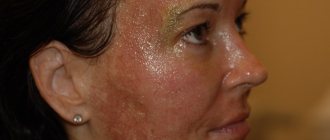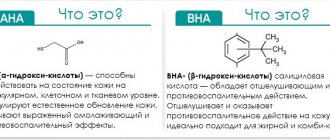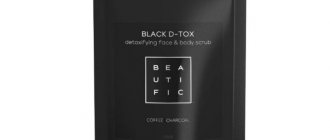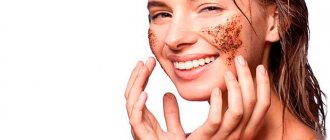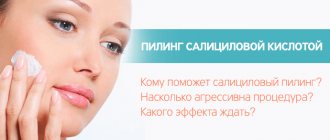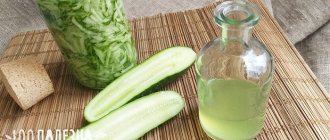During the home facial exfoliation procedure, women are faced with the use of a peeling neutralizer at home - a product for complete post-peel care. This rule, however, applies not only to home peeling, but also to salon peeling - the master is unlikely to cross out the point of applying a neutralizing composition from the protocol of the cleansing procedure. What are these post-pilatory agents and what effect do they have? Is there an alternative to store-bought peeling neutralizers - homemade formulations created with your own hands? And if there is no suitable neutralizing composition at hand, is it possible to replace it with something?
What is a neutralizer needed for?
Neutralization of acid is one of the basic stages of the peeling procedure. This condition is considered essential for any type of exfoliant, including those containing glycolic acid.
Many women, when exfoliating at home, ignore the exfoliant neutralization step. And as it turns out, it was completely in vain. This tool helps eliminate a whole list of problems. The main ones are accelerating the process of skin restoration after peeling. Also, a peeling neutralizer will help relieve a number of problems. The latter may appear on the face after using various exfoliants.
The neutralizing product not only restores the skin, but also effectively stops the peeling effect, because the applied exfoliant must last for a strictly defined time. The peeling composition continues to act on the skin for another 3-4 days after application. A neutralizer applied immediately after cleaning will make the rehabilitation process more gentle.
Due to the wide functionality of post-peeling products, most women have a question: how to properly neutralize peeling at home? The first and most important step is choosing the composition. Before carrying out the exfoliation procedure, a woman must decide which option to choose: salon products or a home neutralizer.
What is a chemical peel and how does it work?
Peeling (from English “to peel” - exfoliate, cleanse) - removal of dead skin cells to improve the quality and appearance.
Chemical peeling is a method of controlled dissolution of the superficial, middle or deep layers of the epidermis and dermis, which takes into account the objectives for the purpose of physiological renewal using special diluted compounds - organic acids or alkaline components. Chemical agents in different concentrations activate fibroblasts to form new collagen and elastic fibers and increase the reparative intercellular capacity.
The procedure renews metabolic, antioxidant and protective processes, corrects age-related changes and normalizes the acid-base and biochemical balances of the skin. After the sessions, regeneration and remodeling of the skin are stimulated and cell activity is restored.
Homemade neutralizer recipes for peeling at home
In a situation where the neutralizer has run out either at the moment or is not available at hand, it is quite possible to make the product yourself. The most popular home remedy of this type is considered to be a soda peeling neutralizer.
It is prepared quite simply: one teaspoon of soda is dissolved in half a glass of boiled water.
We invite you to watch a video on how to do peeling at home:
Advice. A homemade neutralizing composition must be prepared in advance, immediately before the exfoliation procedure. This will save time and stop the action of the elements of the exfoliant distributed over the face in time.
Rehabilitation period
Skin restoration with superficial peeling takes up to 5 days, with medium peeling - up to 10 days, with deep peeling - up to 4-6 months. To prevent unwanted consequences after chemical peeling, it is important to follow the rules.
- Avoid the use of decorative cosmetics in the first 2-5 days after the procedure.
- Do not wash your face during the active post-procedure phase (24-72 hours).
- Use soft cleansers based on hydrophilic oils or plant extracts.
- Do not remove crusts or flakes of skin yourself, but lubricate them generously with cream.
- During the cycle of procedures, avoid traumatic agents and procedures (scrubs, grinding, plastic surgery).
- Limit excessive facial movements for 7 days.
- For 7-10 days, do not visit the bathhouse, swimming pool, sauna, or engage in heavy physical exercise.
- For 14 days, do not sunbathe, do not visit the solarium, but use sunscreen.
- Follow post-peeling care (moisturizers with hyaluronic acid, phospholipids and waxes to restore the epidermis, Panthenol for skin regeneration, vitamin C to strengthen the vascular wall).
- When deep peeling, use antibacterial and anti-inflammatory drugs to stimulate skin healing.
- During the course, maintain an optimal drinking regime and adhere to a balanced diet with limited spicy, fatty foods.
What can you buy from the mass market?
Most modern cosmetic manufacturers produce entire lines of products, including the exfoliant itself, an acid neutralizer and products for other stages of peeling care. Peeling in tandem with a neutralizer can be purchased at cosmetic stores.
Among the most popular neutralizers are the following compositions:
- NEUTRALIZER. It differs from a regular soda solution because it contains potassium carbonate. The latter is more delicate in relation to skin damaged by peeling. In addition, potassium is considered a basic element that promotes cell restoration. In addition to potassium, NEUTRALIZER contains the following useful components:
- Aloe Vera juice helps relieve irritation.
- green tea extract actively moisturizes the skin.
- a complex of peptides accelerates the regeneration process of damaged skin.
The remarkable composition of the product helps to relax the muscles of the face, simultaneously eliminating expression wrinkles
- PHARMIKA. A popular composition especially suitable for post-peeling facial skin care. The drug actively neutralizes the effect of acid chemical peels, having an intense effect on the epidermis. After using this product, the facial skin again feels comfortable after the peeling procedure, since the composition from PHARMIKA soothes the skin, eliminates irritation, and stimulates regeneration processes. Additionally, the product has a deep moisturizing effect, eliminating inflammation. The active ingredients of the product are chamomile and calendula extracts, allantoin, soda.
- GIGI Gr Neutralizer. It is a transparent lotion based on alkali. Designed specifically for neutralizing glycolic peeling after completion of the exfoliation procedure. The product is also suitable for neutralizing azelaic, enzyme, bleaching and other peels. In addition to its main functions, the neutralizer perfectly soothes and softens the skin, eliminating inflammation and discomfort that often occurs after using chemical exfoliants. The neutralizing product contains propylene glycol, hydroxyethyl cellulose, triethanlamine, and water.
- New Line Professional. Gel neutralizer, which is considered one of the means that neutralizes milk peeling and other chemical exfoliants. The special composition of the product softens the aggressive effect of chemical peels, making the procedure softer and more delicate. The texture of the gel allows the product to be gently distributed over the surface of the skin, while being perfectly absorbed. The product dissolves the active substances of exfoliants, has an antiseptic effect, eliminates inflammation and sebum residues, and relieves discomfort and burning sensations. Additionally, the composition has a drying effect on areas damaged by the exfoliant, simultaneously improving the permeability of the keratinized layers of the epidermis. The product helps acids penetrate the skin layers more evenly, enhancing the effectiveness of the exfoliant.
- New Pell Neutralizing Solution. Representative of peeling neutralizers from a Spanish cosmetic company. Effectively stops the acidic effect of exfoliant components, soothes and softens the skin, eliminating signs of post-peeling discomfort. The composition is designed specifically to restore skin acidity during post-peeling application. The product has powerful regenerating, antiviral and analgesic effects. The game hazel extract contained in the neutralizer makes it suitable for the care of mature skin. This component corrects the condition of the network of facial vessels, tightens pores and tones the skin, restoring and soothing it. After using this neutralizer, the skin regains freshness and comfort.
- Neutralizer for chemical peeling Home-Peel. The product is used to suppress the aggressive effects of peelings based on lactic, glycolic and AHA acids. The water base of the product helps it quickly spread over the skin and be absorbed into the epidermis. The product contains a complex of active components that help reduce discomfort and burning during peeling. The neutralizer also increases the rate of dissolution of active peeling substances and restores the acidity level of the skin. The product contains water, propylene glycol, sodium bicarbonate. The product is equally effective for home and salon use.
Indications
- Biological aging - expression lines and deep age wrinkles, dull complexion, thinning, peeling and decreased elasticity of the skin.
- Photoaging is a disorder of the relief of the skin with hyperpigmentation, folds and vascular manifestations.
- Prevention of premature aging.
- Oily, seborrheic skin, acne, post-acne, congestive spots, enlarged pores.
- Dry skin, facial ptosis and signs of sagging.
- Pigment spots - freckles, chloasma, melasma, lentigo, post-inflammatory formations.
- Stretch marks, scars on the body - décolleté, abdomen, thighs.
- Keratomas, papillomas, molluscum contagiosum as part of combination therapy.
- Hyperkeratosis is a thickening of the top layer of skin.
- Preparation for invasive methods of exposure - injection procedures, resurfacing and plastic surgery.
- General disorders of skin quality and appearance in the facial area - periorbital area, cheeks, zygomatic area, forehead and body, neck, décolleté, arms and hands, shoulders, legs, back, abdomen, buttocks.
Features of using a homemade peeling neutralizer
The main condition is the preliminary preparation of a neutralizer to remove peeling based on water and soda. After washing off the peeling with a neutralizer, you should remove the neutralizing composition itself using clean water. After washing, gently pat your face with a soft cloth (do not rub!) and spread moisturizer over the skin.
Attention! When the acids in the peeling and soda solution interact, the face usually begins to burn, and a tingling sensation appears, even greater than during the peeling process. This reaction is considered normal - this is how the acid is extinguished. After some time, the discomfort will completely disappear.
Expected effects
Depending on the type, quantity, and depth of peelings, certain mechanisms occur.
- Exfoliation, cleansing and whitening of the skin (removal of dead cells, age spots).
- Activation of biological functions and cellular resources (antioxidant effect).
- Moisturizing (synthesis of hyaluronic acid).
- Normalization of the sebaceous glands and narrowing of pores.
- General skin rejuvenation (increasing elasticity, smoothing the relief, reducing wrinkles, smoothing out creases).
- Renewal of cellular structures (correction of scars and stretch marks).
- Increases blood circulation and strengthens blood vessels.
- Restoration of skin immunity and barrier functions.
- Achieving skin tightening (lifting effect).
- Normalization of the density and elasticity of the epidermis.
- Formation of new contours and improvement of the structure of the face and body.
How to use purchased neutralizers?
Effective forms of post-peeling care products are considered to be neutralizing tonic or neutralizing gel. This composition has a light texture, spreads evenly and comfortably over the skin, eliminating the effect of peeling acids and renewing the skin. Such products must be used following a detailed protocol:
- Apply the selected acid-based peeling to the facial skin, wait for the time specified in the instructions.
- Distribute the neutralizer over the surface of the skin (it is convenient to use cotton pads), avoiding the area around the eyes.
- After a few minutes, rinse off the product with plenty of warm water.
By the way. During the process of home and salon exfoliation, the client is not immune from possible complications. So, peeling may not be suitable for a particular skin, or its concentration may be too high. In such cases, the notorious neutralizer will again come to the rescue. If, after applying the exfoliant, the face begins to burn unbearably, the neutralizing composition can be applied without waiting for the end of the peeling effect. That is, approximately 2-3 minutes before the exfoliant ends.
Do I need to wash off the neutralizer with water after use? The answer is clearly positive - removal of the neutralizing composition should occur both after home and after salon peeling.
Differences in chemical peels by depth of penetration
- Super-superficial (affect only the stratum corneum of the skin) is a comfortable method for improving the quality of all types of skin. For example, 10% TCA-trichloroacetic acid, salicylic acid, alpha (30% glycolic acid) and beta hydroxy acid (5% salicylic acid), 5-10% retinol, enzymes of plant and animal origin (papain, trypsin).
- Superficial (act on the upper layers of the epidermis without disturbing the basal layer) - safe, painless, quickly renew, moisturize the skin without injury and enhance the formation of collagen and elastin with the help of weak acids. For example, 15-20% TCA, 30-50% glycolic and 20% salicylic, fruit acids (lactic, tartaric, mandelic), resorcinol.
- Median (penetrate the entire thickness of the epidermis and dermis to the papillary layer within living structures). They have a moderate painful, pronounced rejuvenating effect, improve the structure of the skin, activate the synthesis of new cells, and provide long-lasting results due to high concentrations of active components. For example, 25-30% TCA, 70% glycolic acid, 30-40% salicylic acid, Jessner's solution, 50% fruit acids.
- Deep (captures the epidermis and the entire thickness of the dermis, leaving small “islands” of tissue for regeneration). Correct significant defects and restore cellular resources. They are rarely performed in a hospital setting using anesthesia due to severe pain and possible complications. For example, phenol preparations.
What can replace the neutralizer?
For some reasons, most often for the purpose of saving money, some women sometimes have a question: how to replace the peeling neutralizer. The fact is that facial exfoliation is not a procedure on which you should save much, at least as far as the neutralizer is concerned.
Thus, peeling, the effect of which is superficial, can be neutralized with a strong extract of chamomile. Some women use a gentle, delicate milk to remove makeup for these purposes and rinse their faces with the same chamomile decoction. However, if we are talking about mid-acid (not to mention the most serious - deep) peeling, the choice of neutralizer should be taken seriously. In these cases, you should select only high-quality and proven products.
Story
Chemical peeling is one of the oldest cosmetic procedures with successive stages of practical development and deepening of knowledge in different historical periods. The technique has made a transition to the use of effective, safe, less traumatic and “year-round” drugs.
There is a certain sequence in the study of peelings.
- Ancient Egypt - the use of milk and fractional mineral, fruit, sand fragments in special compositions.
- Middle Ages - the use of substances from grapes and citrus fruits for rejuvenation and whitening of the entire body.
- 1883 - German physician Paul Gerzon Unna discovered the effectiveness of TCA, salicylic acid, resorcinol and phenol in the treatment of age spots and post-acne manifestations.
- 1974 - Eugene Scott unveiled the use of alpha hydroxy acids, Professor Albert Kligman discovered the healing properties of vitamin A for the skin.
- The end of the 90s marked the beginning of widespread chemical peeling in Russia.
Side effects and complications
Predictable.
- Erythema is redness of the skin, which depends on the concentration of substances and lasts up to 2-3 hours with superficial peeling, up to 5 days with medium peeling, and up to 2 months with deep peeling.
- Exfoliation is the removal of a thin layer of dead cells. It can be small-plate for superficial peeling and large-plate for medium peeling. Duration varies from 3 to 7 days.
- Swelling after chemical peeling is a natural reaction to a violation of the integrity of the skin and an increase in capillary permeability during medium and deep peelings. Stores for 2 to 4 days.
- Changes in skin color (darkening) are response mechanisms due to peeling, which lasts up to 14 days.
- Sensitivity is a manifestation of skin reflexes to the penetration of products, which persists for 14 days.
Undesirable (as a result of improper post-procedure care, individual characteristics or after poor-quality implementation of the technique). They are divided into immediate (up to 2 weeks after the procedure) and delayed (from 3 to 10 weeks).
- Exacerbation of acne is an inflammatory reaction characteristic of oily skin. Antibiotics are prescribed to suppress the processes.
- Activation of herpetic infection - occurs in the absence of a preventive course before peelings. If a rash occurs, antiviral medications are recommended.
- The addition of a secondary infection is manifested by pustular rashes due to non-compliance with antiseptic rules and a proper recovery period. Local or systemic antibacterial agents are used.
- Allergic reaction - to prevent the appearance of rashes, a test test is first carried out on a limited area of the skin to identify possible manifestations. When they occur, antihistamines (for example, Erius) are used.
- Persistent redness of the skin - occurs when blood vessels are dilated after deep peeling. In this case, it is important to follow the necessary recommendations after the sessions.
- Hyperpigmentation is the activation of cells that produce pigment (melanin). In this case, pre-peel preparation and the use of retinoic and phenol peels are important, as well as mesotherapy to reduce age spots.
- The demarcation line is a clear boundary between the treated and undamaged areas of the skin. Leveled by Jessner peeling.
- Scars (hypertrophic, keloid) - appear with medium and deep chemical peels. Corrected by laser exposure, ozone therapy, electrophoresis with lidase.
Combination with cosmetic procedures
Chemical peels are harmoniously integrated into various cosmetology techniques to enhance the effect.
- The introduction of botulinum toxin and fillers for additional correction of age-related changes occurs 2-3 weeks after superficial-medial peelings.
- Mesotherapy - the introduction of specialized cocktails into the middle layer of the skin to stimulate cellular processes of self-regulation and renewal is carried out before or after procedures in 3-10 days.
- Biorevitalization - the use of preparations containing hyaluronic acid to maintain the required level of hydration and increase regeneration is carried out 5-10 days after superficial and medium peels.



